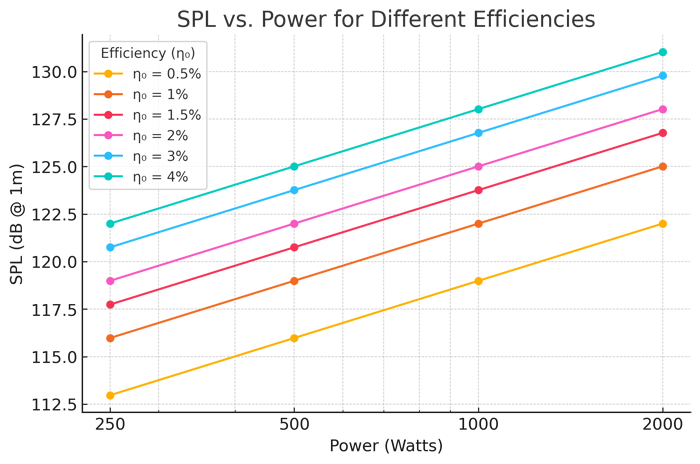Pe – Power Handling Capacity
Pe – Power Handling Capacity
Pe represents the thermal power handling capacity of a speaker driver, measured in watts (W). It indicates how much continuous power the voice coil can handle without overheating or suffering permanent damage. The test is done in a controlled environment with specific cabinet volume and controlled room temperature. The test environment may not be the same as your speaker design, for instance some manufacturers conduct their power tests for 18″ woofers in a very large cabinet (900 litres) which could be 6-8 times the size of your cabinet. This has a different volume of air, which can affect heat dissipation. Very small chambers in cabinets can adversely affect the power handling and make it much lower in real life than the manufacturers specifications
Power handling is not the same as loudness—a higher Pe rating doesn’t necessarily mean a louder speaker, as efficiency (η₀) and sensitivity (SPL @ 1W/1m) also play key roles. Many manufacturers rate Pe using AES, RMS, or program power standards, which define how power limits are tested. Manufacturers sometimes use slightly different parameters for their power calculations, such as whether they use minimum impedance, average impedance or nominal impedance to determine the power, which can distort results. Its worth checking this out in critical applications
Power Handling vs. Loudness – Why More Watts Doesn’t Always Mean More SPL
A higher power handling (Pe) doesn’t automatically mean a louder speaker—it only tells you how much power the driver can withstand before thermal failure. The actual loudness (SPL) depends on both efficiency (η₀) and sensitivity (SPL @ 1W/1m).
For example, consider two 18″ woofers:
- Woofer A: η₀ = 3%, 500W Pe
- Woofer B: η₀ = 1.5%, 1000W Pe
Even though Woofer B can handle twice the power, it has half the efficiency, meaning it produces the same SPL (or less) at full power as Woofer A does at half the power.
This is why efficient PA speakers can often achieve the same or greater loudness with less amplifier power, reducing thermal stress and power compression. If a speaker is inefficient, throwing more watts at it only results in more heat, not necessarily more sound.
The graph below illustrates the difference between high and low efficiency woofers, comparing the worst case (0.5% efficiency) you would need 2000W to reach to the SPL of a very efficient woofer (4% efficiency) operating at 250W. That’s a lot of extra power and heat to deal with.

For more info on power ratings, including AES vs. RMS vs. Peak Power, check out this article:
What’s Up With the Watts?